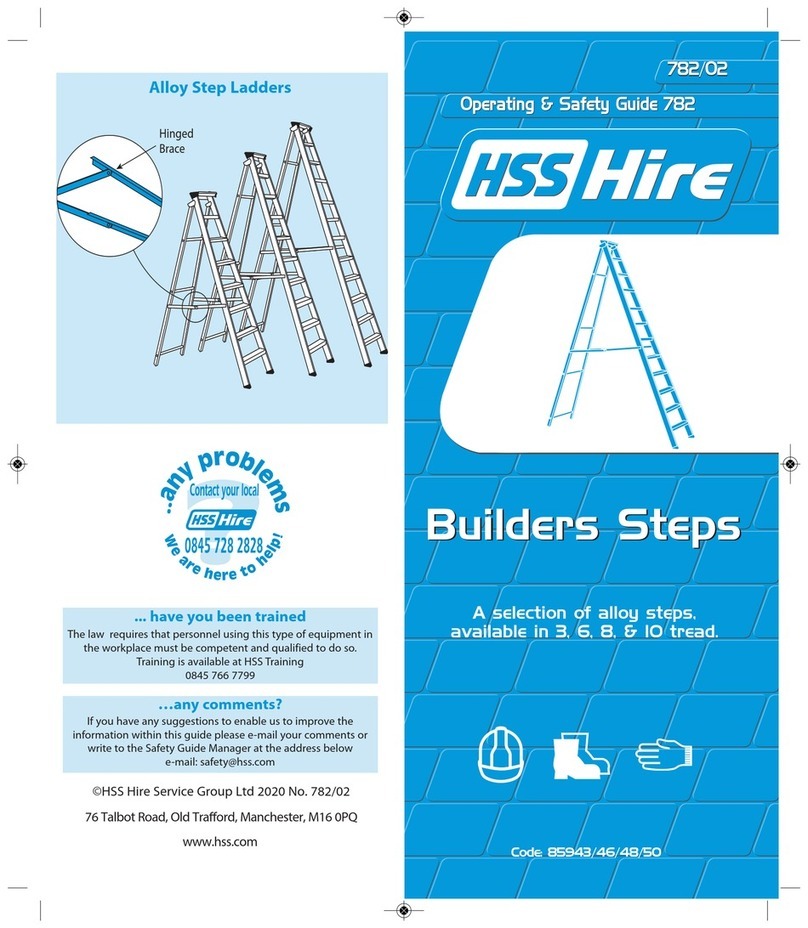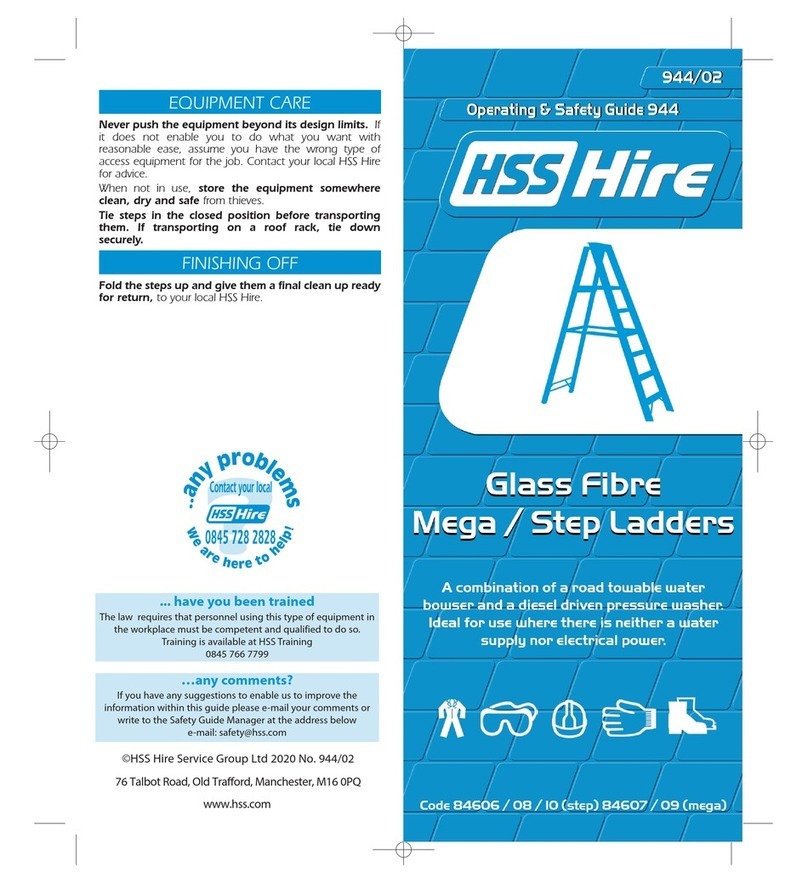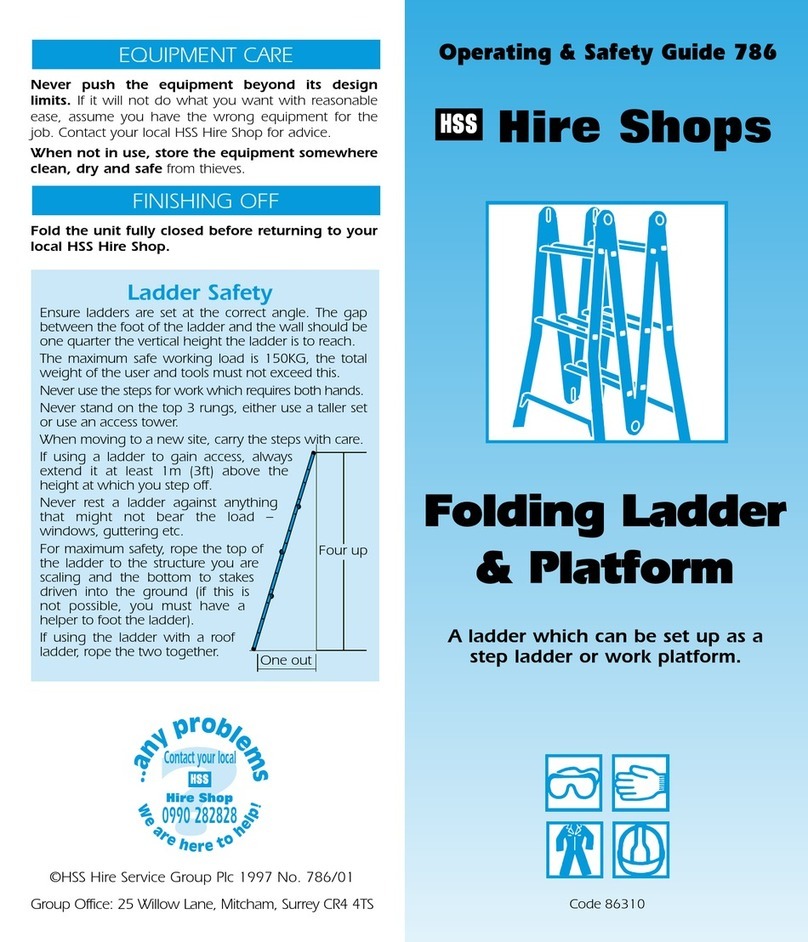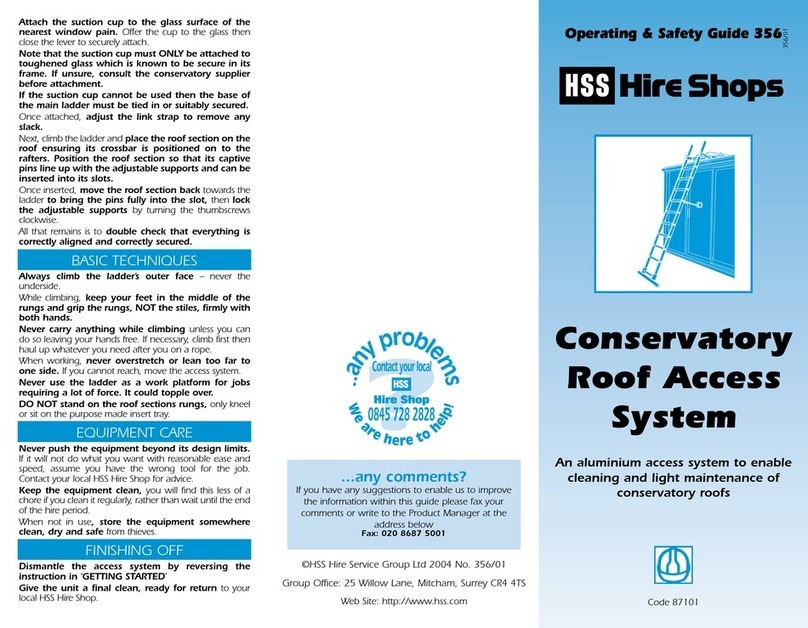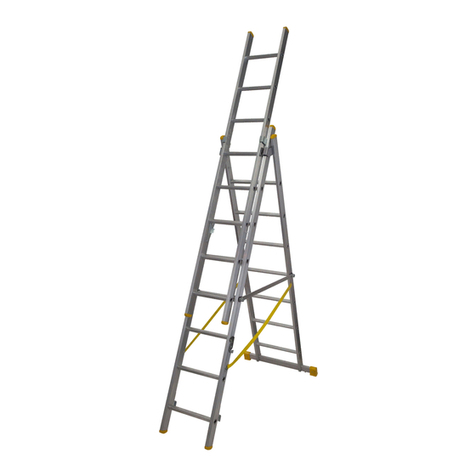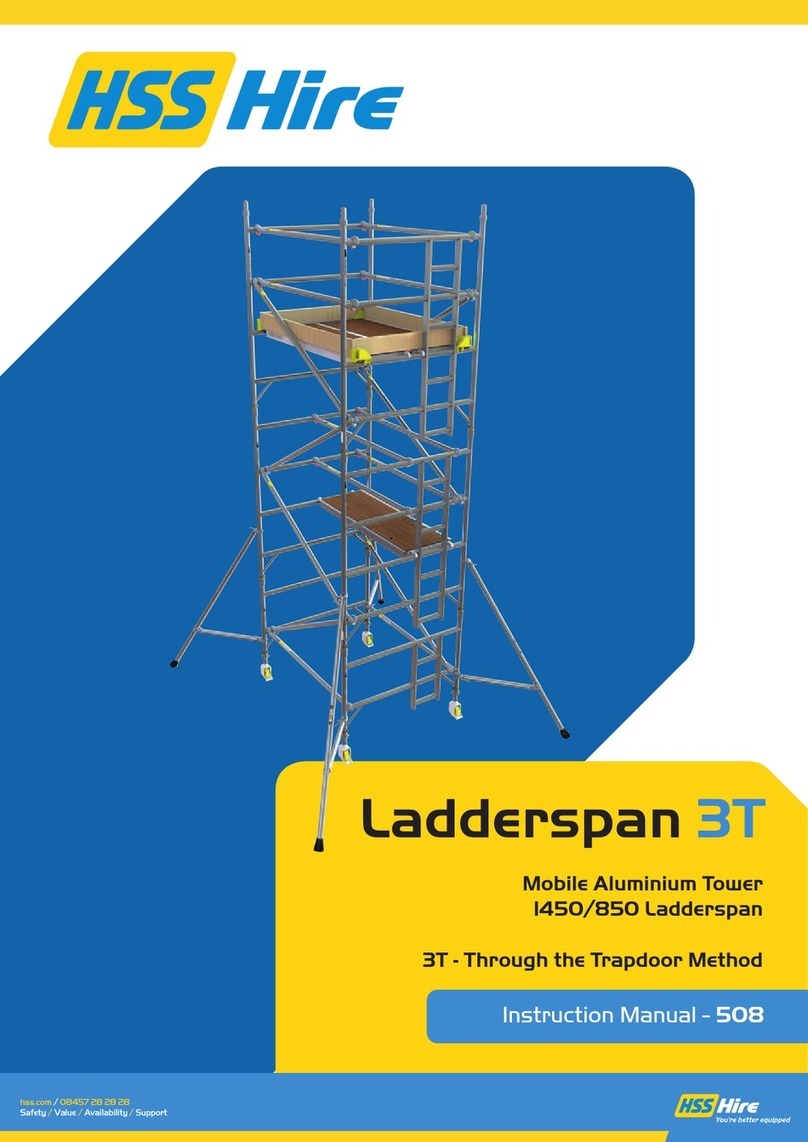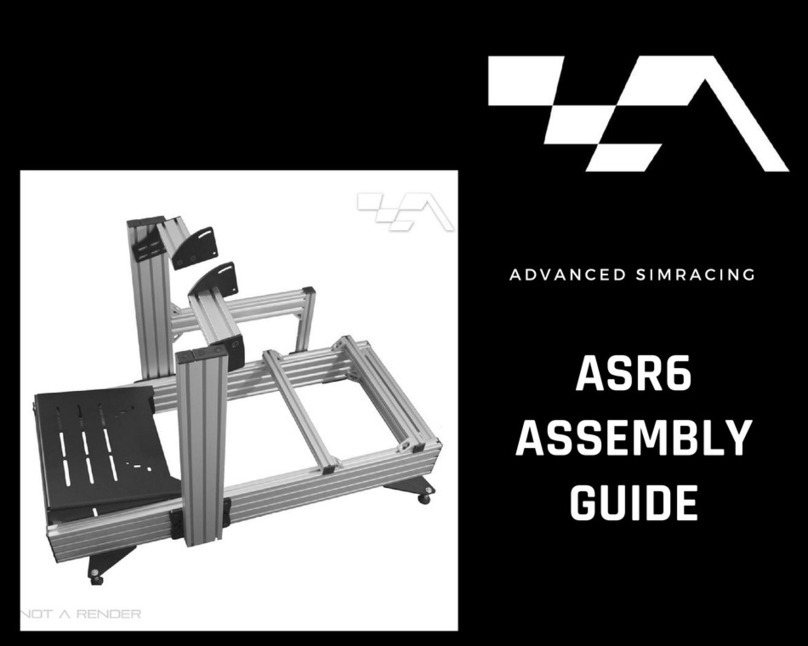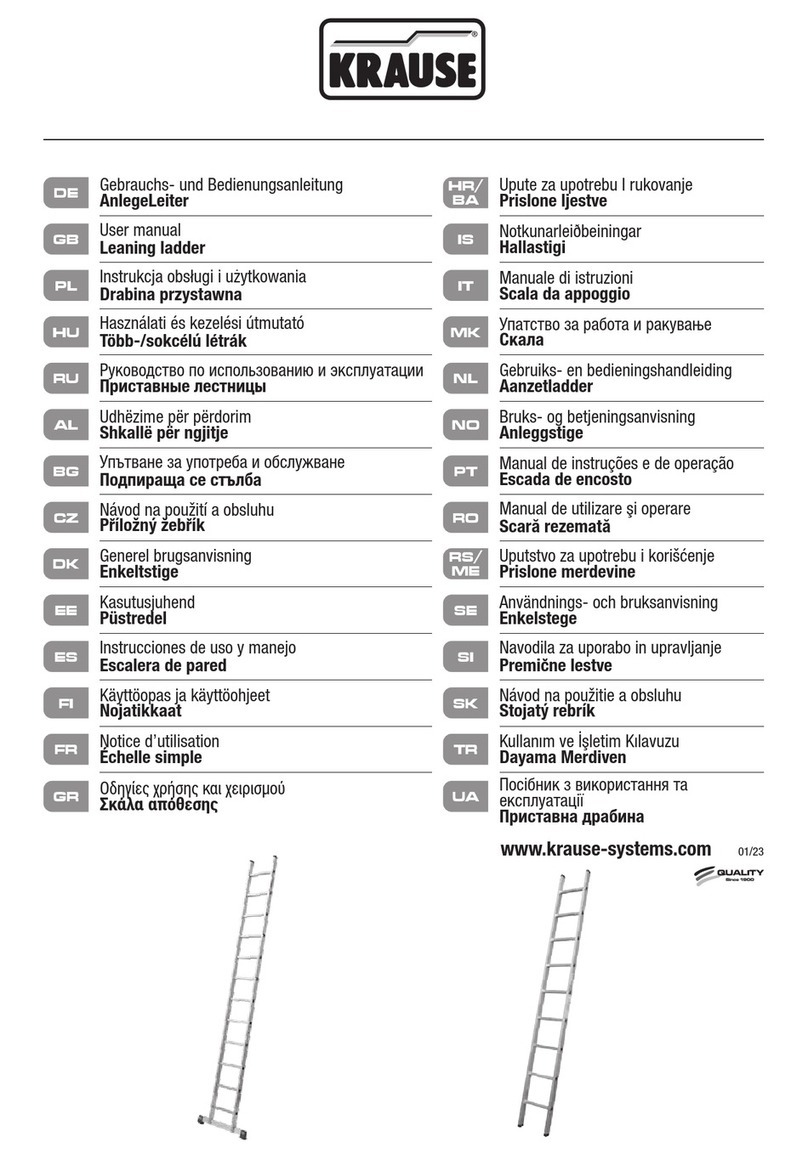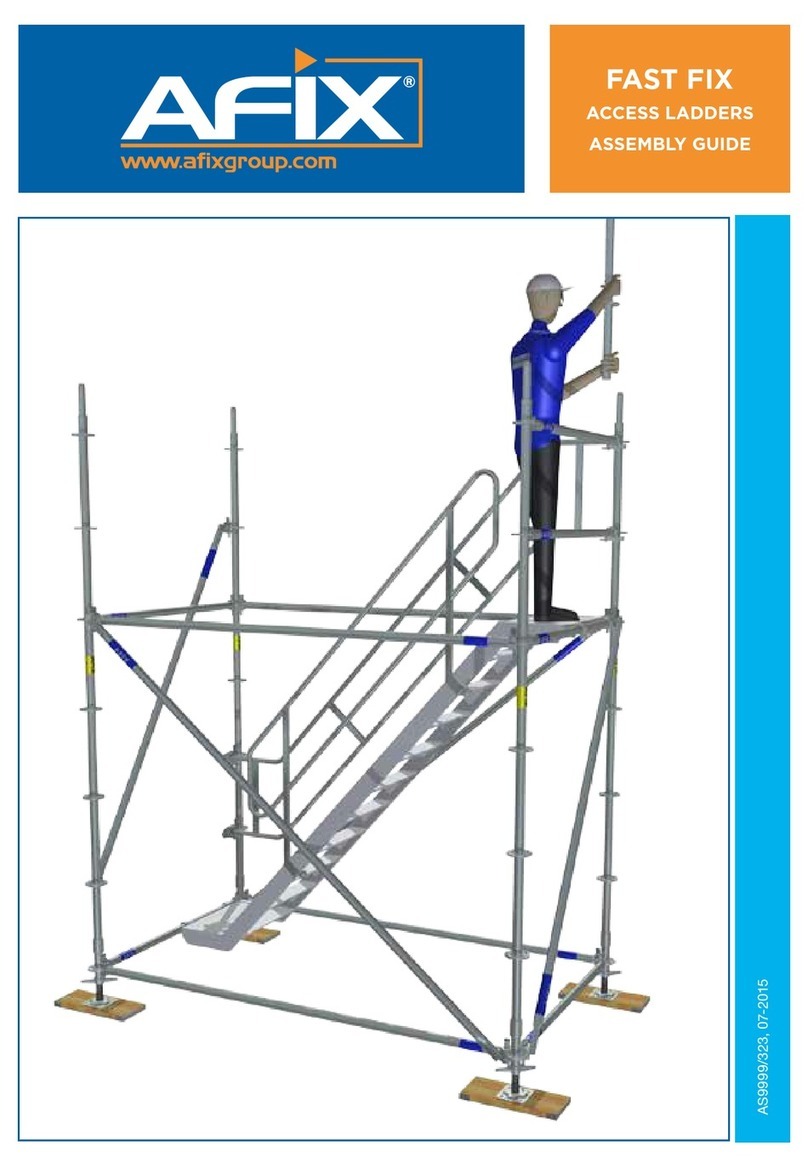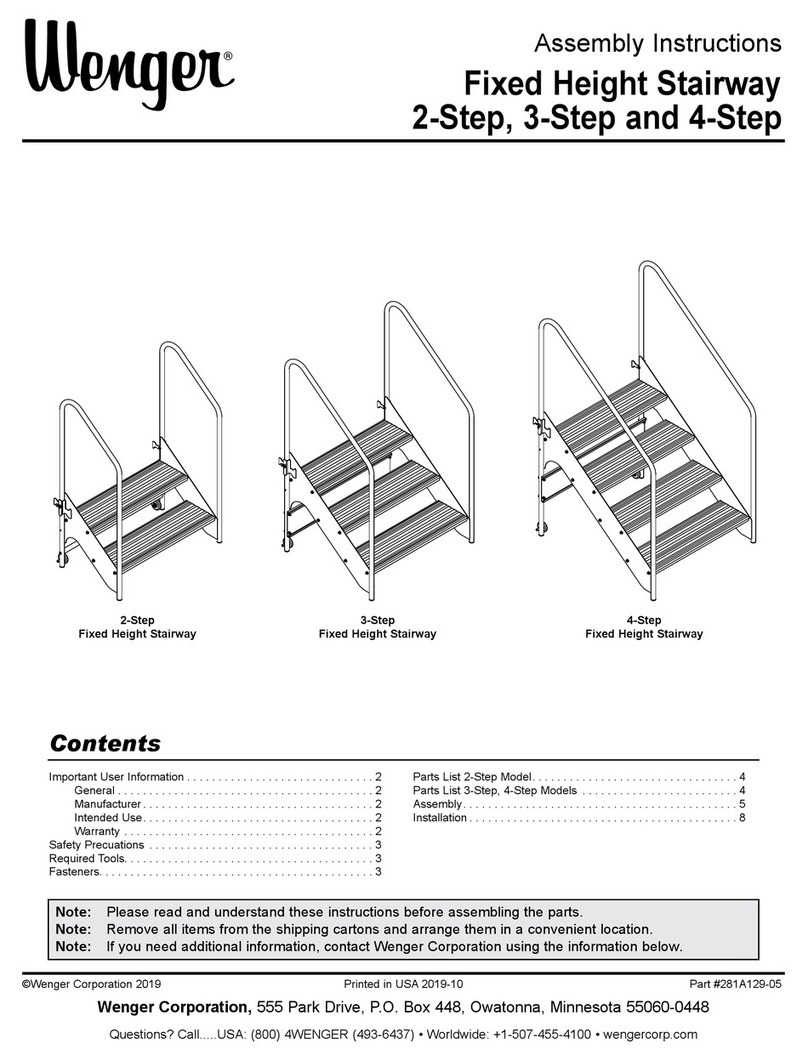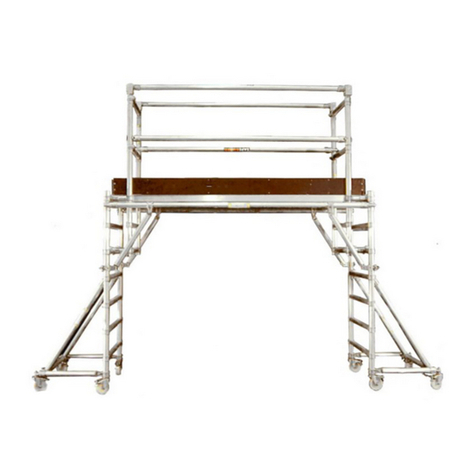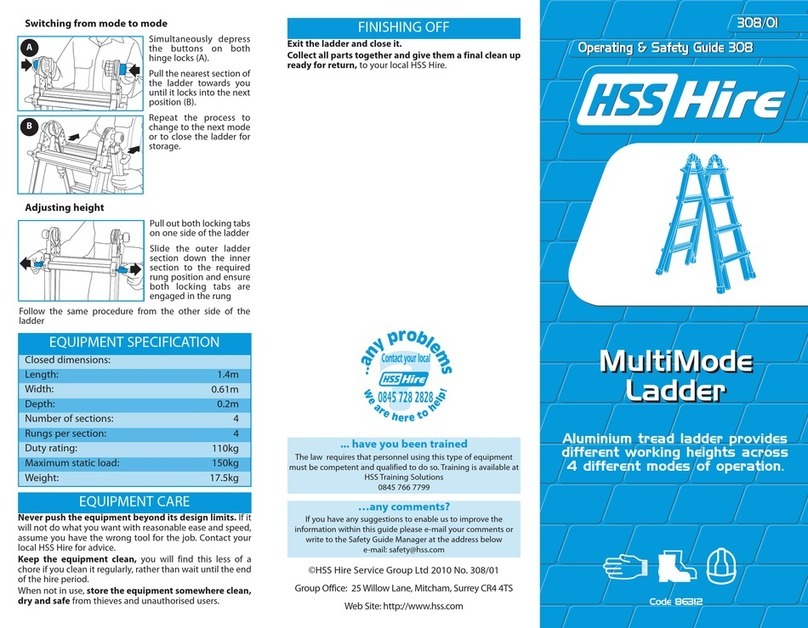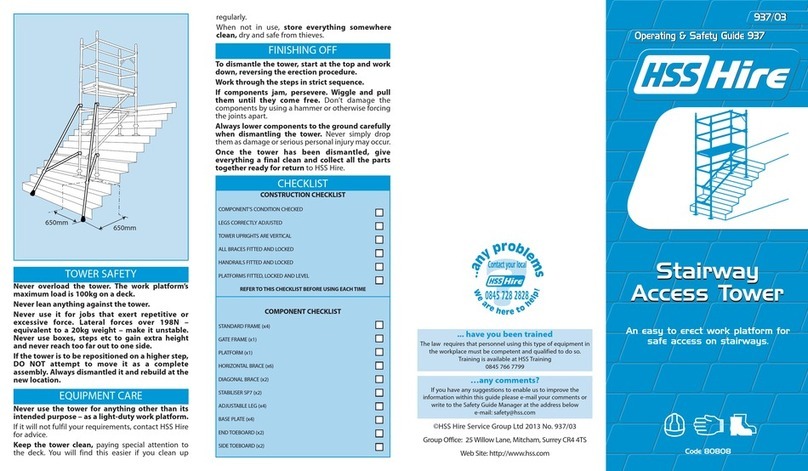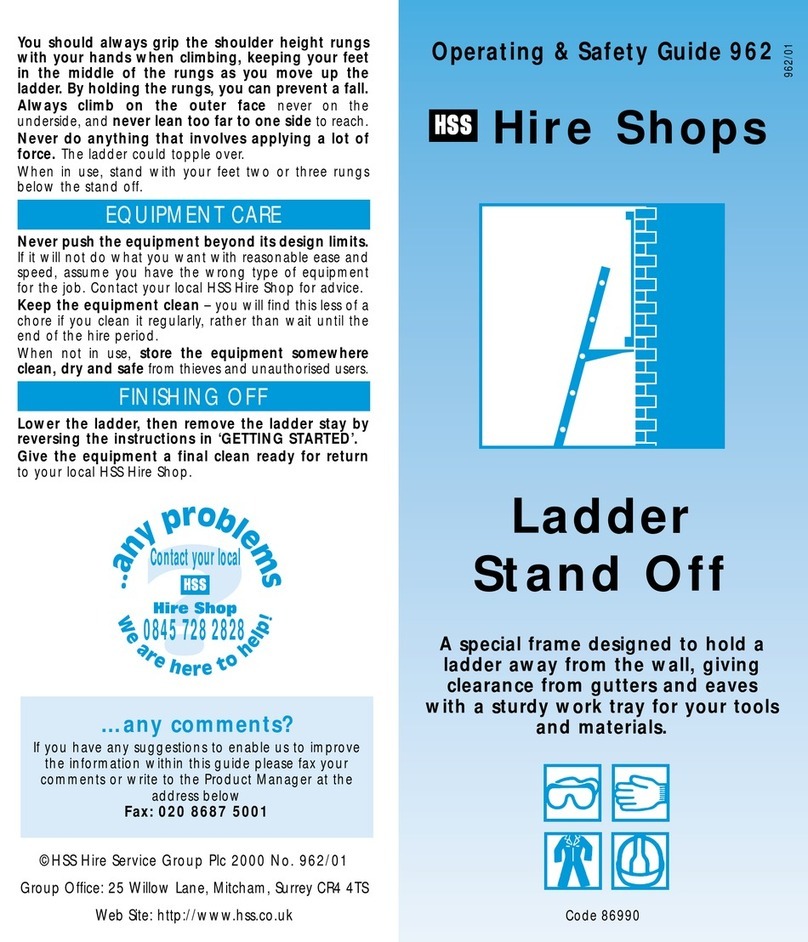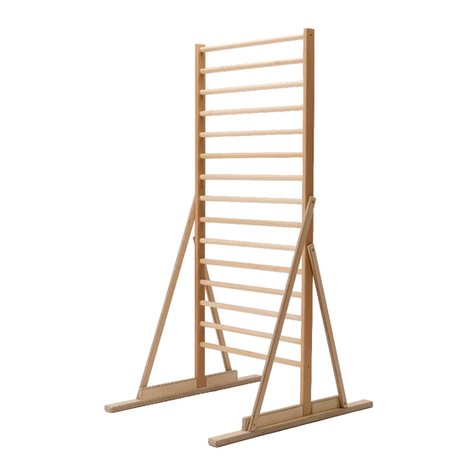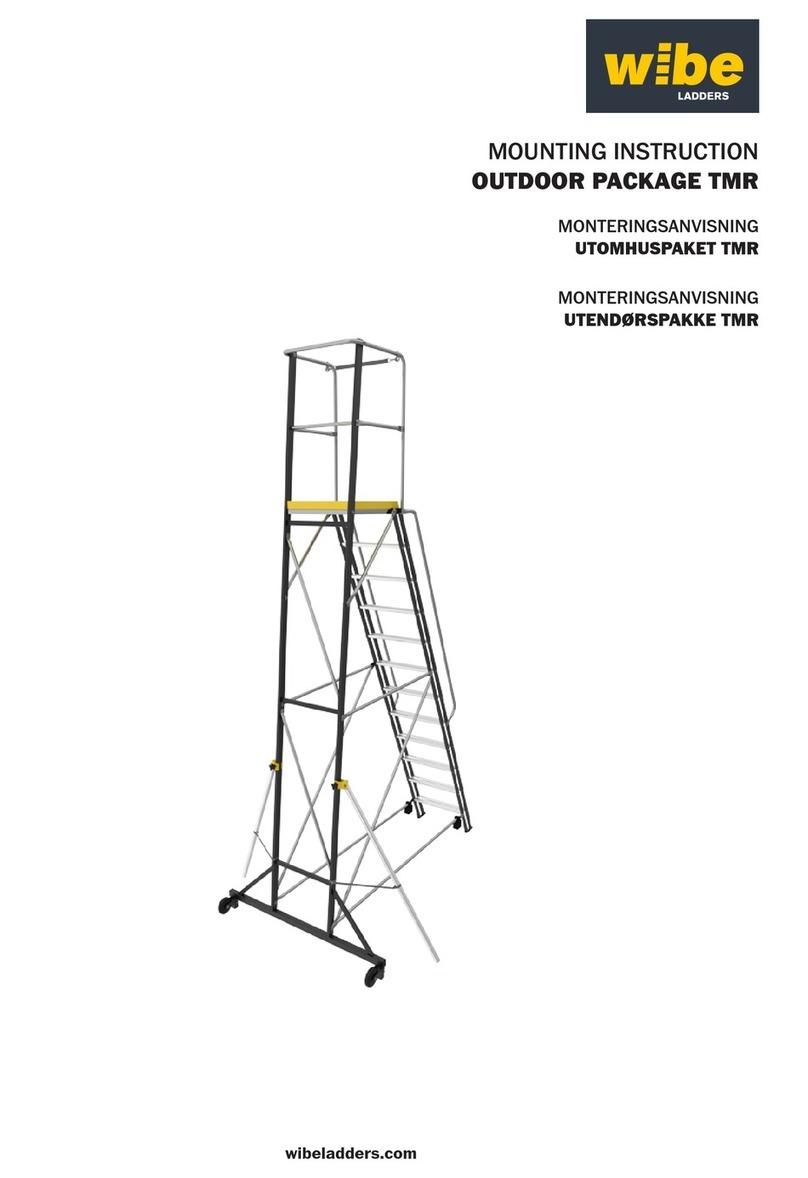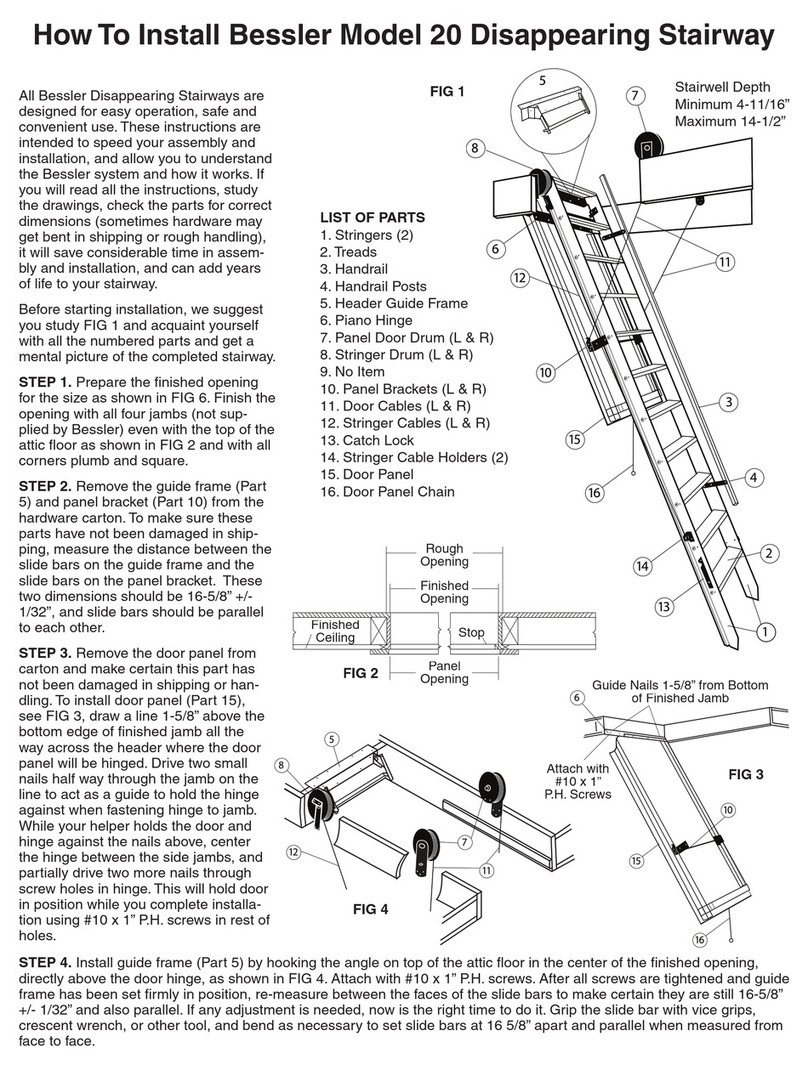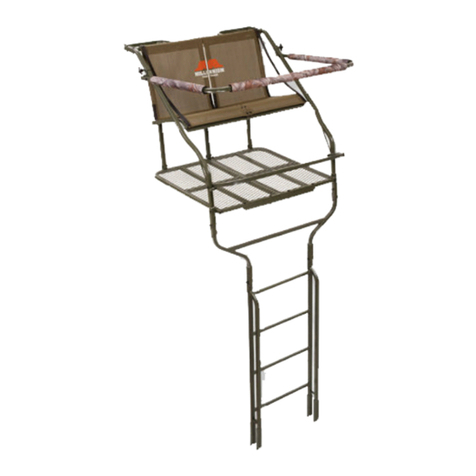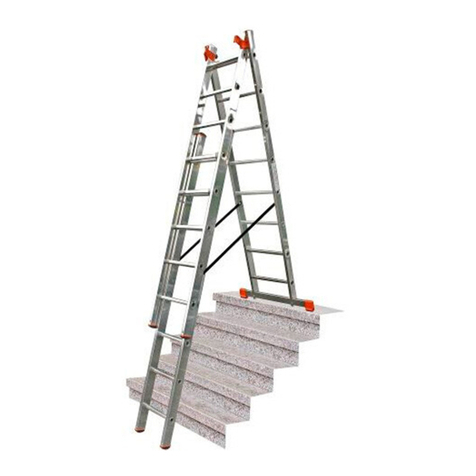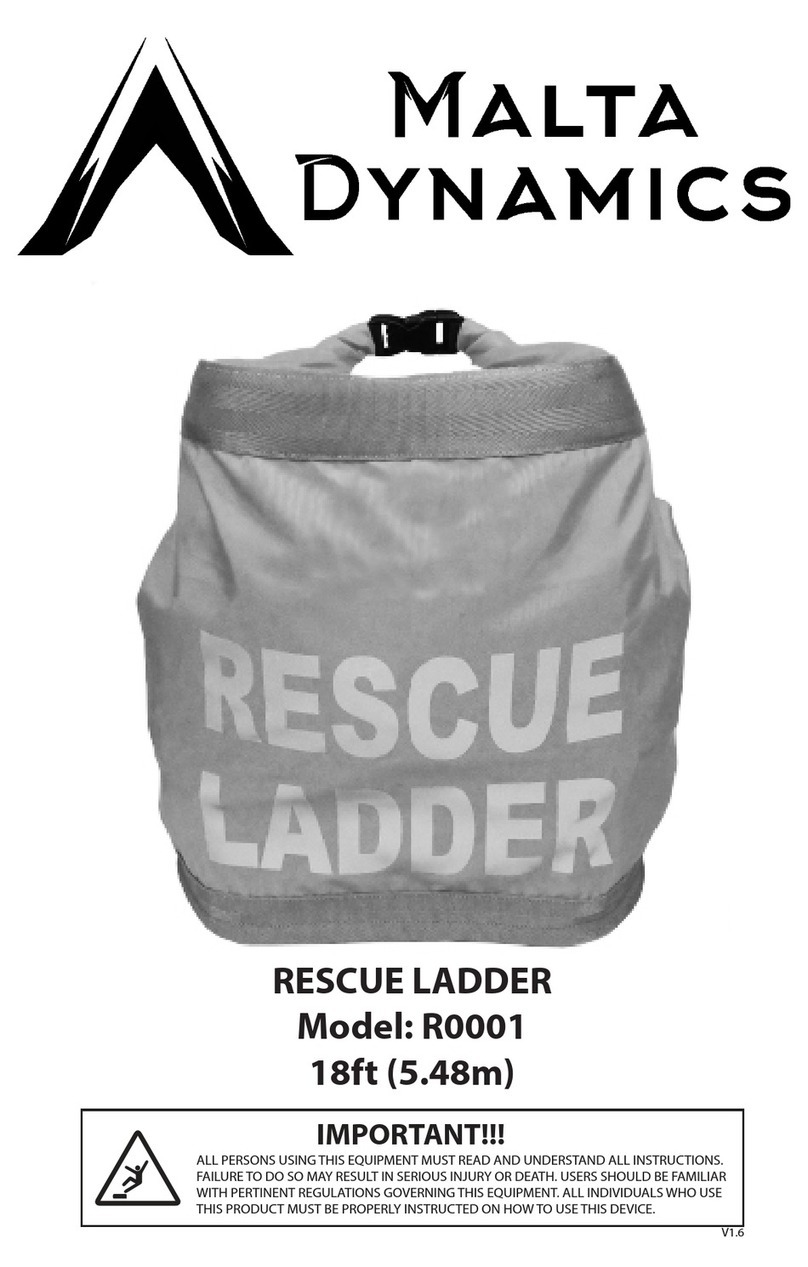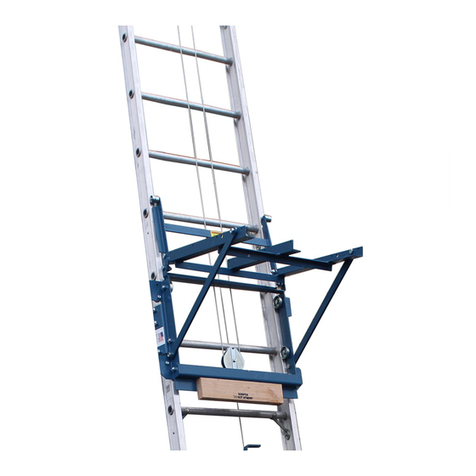
ASSEMBLY
THIS TYPE OF STRUCTURE MUST BE ERECTED BY
OPERATIVES WITH A PASMA CERTIFICATE &
PRODUCT SPECIFIC TRAINING
NEVER STAND OR WORK ON AN UNPROTECTED
PLATFORM
DO NOT EXCEED THE SAFE WORKING LOAD OF
150KG ON THE BEAM UNIT PLATFORM
Fully insert the adjustable
legs with castors into 2
frames, turning the leg’s
height adjustment collar to
bring each leg 25mm from the
lowest position.
1
Attach a guardrail brace
panel to the vertical tube
of one frame with the
upper claw positioned
above the fourth rung and with
all claws facing outward. Make
sure the claws are correctly
locked on the frame tube. Now
attach the second frame to the
guardrail brace panel to create
the base frame assembly. Lock all
four castors and using a spirit
level as a guide, adjust each leg
to bring the base square and
level.
2
Construct 2 sets of
conjoined frames, these
will give you two 2m
sections and will speed up
the erection process. Release the
frame clips on one four rung
frame and fit it on to a second
four rung frame. Apply the frame
clips and ensure they are
correctly locked. Repeat this
with the second set. Fit one set
of conjoined frame and apply
the frame clips. Repeat this with
the second set.
3
Next attach one guardrail
brace panel with its lower
jaw position above the
sixth frame rung. It must be
fitted on the opposite side to the
first guardrail brace panel to
ensure stability. Ensure all claws
are facing outward and correctly
locked on the frame tube.
4
Stand inside the tower and fit
the platform on the eighth
rung, making sure that the
wind-lock catches engage
5
Fit a stabiliser to each corner of
the tower. Position the lower
horizontal stabiliser coupler
clamp just above the frame’s
second rung, then secure the top
stabiliser coupler clamp just above
the frame’s fifth rung. Adjust the
stabilisers so that you create as
square a footprint as possible . Adjust
each stabiliser’s length so that they
are in contact with the ground. Make
sure all coupler clamps are correctly
secured. Extend and lock the four
component hangers located on
either sid of the platform
6
Place three guardrail brace
panels on to one set of hangers
and a pair of eight rung
conjoined frames to the other
side. Enter the tower framework and
climb the frame rungs until you are
half way through the platform trap
door. Now manoeuvre yourself so
that you are sitting on the platform,
with your legs through the trap door
and your feet on the frame rungs.
From this position, you should take a
guardrail brace panel, one at a time,
and attach so that the upper jaws are
positioned above the twelfth rung.
With both panels in position, you may
access the platform.
7
Fit one set of conjoined frames
to each end of the tower and
apply the frame clips. Next,
attach the guardrail brace panel
with its lower jaw positioned above
the fourteenth frame rung. Ensure all
claws are facing outward and
correctly locked on to the frame tube.
Descend the tower and from the
ground place two guardrail brace
panels onto the hangers on one side
of the platform then a set of toe
boards and a platform on the other
side.
8
Access the tower then carefully
fit the second platform on the
sixteenth rung, making sure
that the wind-lock catches
engage. Extend and lock the four
component hangers located on either
side of the platform. Transfer the two
guardrail brace panels and the set of
toe boards to the component hangers
on the second platform
9
Position yourself so that you are
half way though the second
platform’s trap door. Now
manoeuvre yourself so that you
are sitting on the platform, with your
legs through the trap door and your
feet on the frame rungs. From this
position, you should take each of the
guardrail brace panels, one at a time,
and attach so that the upper jaws are
positioned above the twentieth rung.
10
With both panels in position,
you may access the platform.
Unfold the toe board set and
position so that they sit on the
outer edge of the platform. Finally,
retract all hangers and the tower is
now complete and ready to use.
11
Any platform fitted to the tower at
any stage may be used as a work
platform, provided toe boards and
guardrail brace panels are fitted.
STABILISERS POSITIONING
Stabilisers are supplied and must be used in any
heights. For maximum effect arrange the stabilisers by
positioning at an angle of 45 degrees to give a footprint
as close to square as possible.
If the tower is to be positioned agains a wall, the
stabiliser footprint can be altered (see figure), but only
when the height of the wall is a minimum of two third
of the height of the top working platform.
Ensure that all four stabilisers’ feet are in contact with
the ground and that the ground can support the weight
of the tower and stabilisers.
DISMANTLING
The tower is easily dismantled by simply reversing the
erection procedure. Make sure that the component
hangers are evenly loaded to ensure the tower remains
balanced. You must, however, be protected by guardrail
brace panels when standing on any platform and
ensure that you use the 3T method when removing
guardrail brace panels.
4 rung Frame
Telescopic outrigger
Hatch platform
Guardrail brace panel
220mm adjustable leg
125mm locking castor
Toe board set
Tower weight
4
2
4
1
109 kg
QUANTITY SCHEDULE
Platform safe working load
10
150 kg
7
4
assembly. During erection, the frames may be connected
together to create 2m high frames which makes assembly
both quicker and easier.
THROUGH THE TRAPDOOR SYSTEM (3T)
The 3T method of construction has been developed to
reduce the risk of an erector falling from a tower during
construction. The erector must sit on the platform with legs
through the hatch and feet on the frame rungs when
attaching guardrail brace panels above the platform. This
ensures the erector is always protected be a set of guardrail
brace panels.
PREPARATION
The floor area must be clear of any obstructions
including materials and debris. Check that you have all
components necessary to construct the tower height
you require. Check also each component for condition
and correct function. If any part is missing or damaged /
not working correctly the tower should not be erected. In
this case return unit to HSS Hire.
You should consider tying in the tower to add stability, but
this may only be carried out by a suitable trained person.
Ballast must be used to stabilise against overturning. Only
use solid material as ballast (i.e. block of concrete) and
position to avoid overloading individual components.
Ballast should be supported by the base of the tower and
securely fastened to prevent removal.
COMPONENTS
Guardrail Brace Panel
Claws are fitted to the guardrail brace
panels and each has an automatic
locking jaw which is released by simply
moving the jaw’s trigger. The claw must
only be attached to the frame with the
opening facing outward. Attachment
with the jaw’s opening facing inward
will not fully protect the user if lent
upon and may cause serious injury or death. Always ensure
that each claw is positively locked in position before using
the tower.
Frame Clips
The frame clip’s pin locates into a
retaining hole in the frames to lock
tower sections together when
place one on top of the other. The
pin is locked in place by a red tab
to ensure that it remains in place.
From the disengaged position,
pivot the pin / tab to bring the pin
horizontal. Insert the pin fully through the retaining hole
with its tail pointing down. Next flip the tab vertically to
lock the pin in place. Removal is simply a reversal of the
fitting sequence.
Stabiliser Coupler Clamp
The coupler clamps are used to
secure the stabilisers to the tower’s
vertical tubing. With the clamp jaw
open, offer it to the tube. Bring the
jaw around the tube and set the
buckle on to the hook, then close the
clamp arm to lock the stabiliser in position. A similar clamp
is fitted to the stabiliser extension leg.
Wind-lock Catch
The wind-lock catch is drop down
jaw fitted to the side of the hatch
platform’s mounting hook and
prevents the platform from lifting in
windy conditions. It is attached to the
horizontal tube of the frame. To
disengaged, simply lift and hold the jaw as you rise the
platform clear.
Platform with built in Component Hangers
To enable one man to erect the
tower, each hatch platform is
fitted with four component
hangers which are stowed (two
either side) within the platform’s
frame. The hangers can be
extended when needed and
retracted when not. To extend
and lock a hanger, take a hold of
the hanger stop end and pull from the frame. Once the
stop rivet is clear of the slot, turn the hanger 45 degrees
anticlockwise then gently slide back in until it stops. To
retract the hunger, simply reverse the procedure.
Adjust Leg and Castor
The adjustable leg and castor
allows for accurate
positioning of your tower in
relation to your workplace.
The legs can be extended or
retracted to allow for
levelling and the brake must
be applied to prevent
movement.
Engaged Disengaged
Retract
Extend
Lock
Release
Retract
Extend
Off
On
Engagement
spring
SAFETY WARNING
Only use adjustable legs to level the tower
and not gain extra height.
When the tower needs to be moved a small distance to
enable you to continue your task, this can be achieved
provided the stabilisers can remain in pattern and all
tools, materials and personnel are removed from the
tower.
You will need to rise the stabilisers so that they are
no more than 25mm above the floor and properly
locked. However if the stabilisers need to be positioned
and this reduces the footprint, the tower must be
reduced in height to 2m.
You must only move the tower by manual effort at
the base at a slow pace and only after fully assessing
the risk.
Once moved, always check the tower before using.
If the unit is to be moved to new location, a new level or
over the rough terrain, it must be fully dismantled and
rebuild at the new location.
MOVING TOWER
WARNING
The hangers are intended for hanging of components
during the erection of the tower. Do not use the hangers
other than to their intended purpose.
DANGER
Do not exceed maximum weight of 20kg per hanger.
